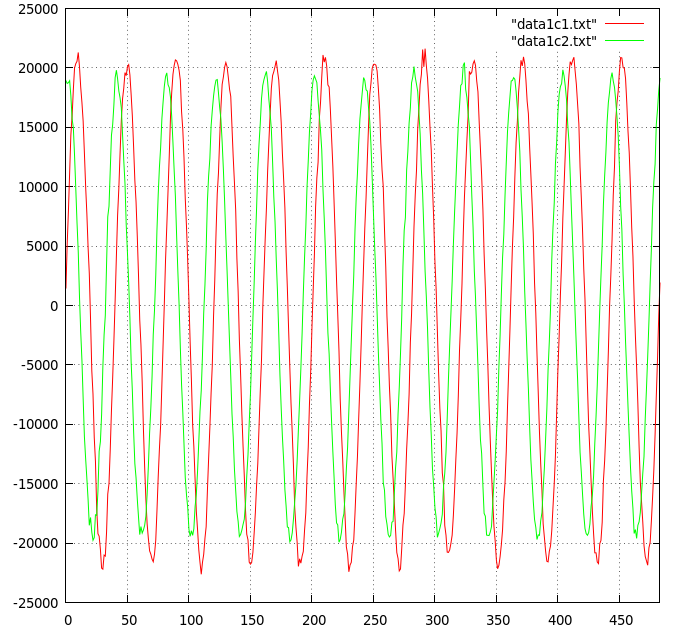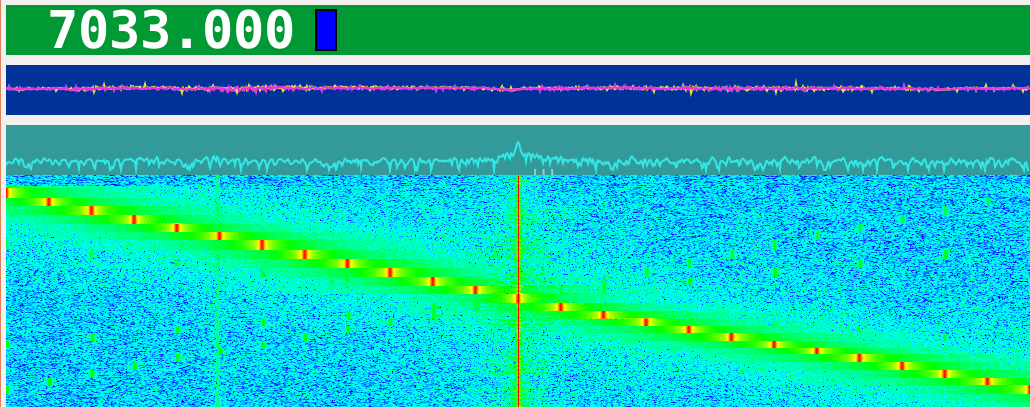Here is a raw IQ data plot for 12 cycles, which contain 484 samples. We are going to obtain parameters to correct the gain and the phase errors. First, the DC offset.
% awk 'BEGIN {n=484} {a=a+$1; b=b+$2} END {print a/n,b/n}' data1c.txt
-246.618 -222.262
We assume, after correcting the DC offset, that I’=A*cos(wt) and Q’=B*sin(wt+C). Then we have (I’,Q’)=([A,0],[B*sin(C)+B*cos(C)]) (cos(wt),sin(wt)). By inverting the 2×2 matrix, we have (I,Q)=([B*cos(C),0],[-B*sin(C),A]) (I’,Q’), where I and Q are ideal (and normalized) IQ signals, namely cos(wt) and sin(wt).
Noting that /I’I’/=(1/2)*A^2, /Q’Q’/=(1/2)*B^2, and /I’Q’/=(1/2)*A*B*sin(C), we have A=sqrt(2*/I’I’/), B=sqrt(2*/Q’Q’/), and sin(C)=(2/(A*B))*/I’Q’/, where /*/ is defined to be the average over the period.
% awk 'BEGIN {n=484;d1=-246.618;d2=-222.262} {a=a+($1-d1)*($1-d1); b=b+($2-d2)*($2-d2)} END {print a/n,b/n}' data1c.txt
2.24414e+08 1.89215e+08
Therefore, /I’I’/=2.24414e+08, and /Q’Q’/=1.89215e+08, which means A=21185.6, and B=19453.3.
% awk 'BEGIN {n=484;d1=-246.618;d2=-222.262} {a=a+($1-d1)*($2-d2)} END {print a/n}' data1c.txt
6.3263e+07
Next, /I’Q’/=6.3263e+07, which means sin(C)=0.30701, or C=0.31204[rad]=17.879[deg].
And finally, we get B*cos(C)=18513.86, and -B*sin(C)=-5972.26.
If we multiply a constant, 1/B*cos(C), to the matrix ([B*cos(C),0],[-B*sin(C),A]) so that I’ becomes immediately I, as we assumed in our previous articles, we have:
(I,Q)=([1,0],[-tan(C),A/(B*cos(C))]) (I’,Q’)=([1,0],[-0.32258,1.1443]) (I’,Q’)
My first guess by observations was that “C1 to be -0.32 and C2 to be 1.14”, and it proves that I guess very exactly!


